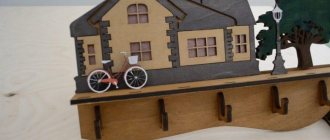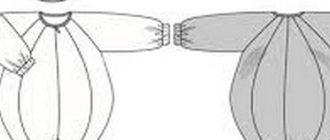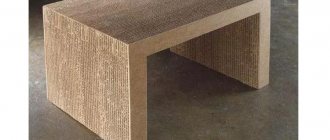Area of use of the tongue-and-groove connection
The tongue-and-groove fastening is used today in many areas. For example, it is used for laying almost all types of flooring, except linoleum and carpet. MDF, chipboard, and fiberboard boards are also connected in a similar way.
Due to the advantage of wood, such as environmental safety, it is much more often chosen than other materials to create various pieces of furniture (from a traditional kitchen chair to a simple wall in the hallway) and certain types of curtains (roller blinds, blinds).
Manufacturers of most of these products prefer tongue-and-groove technology.
The construction of various buildings from timber, the manufacture of a ceiling system, the installation of a roof - all these works cannot be completed without the use of a tenon joint.
On the issue of fixation
Half-timber joinery joints do not have a mechanical connection, so they are secured using gluing. We discussed in detail how to properly glue wood and choose the appropriate glue in previous materials.
While drying, the structure must be secured with clamps. When placing the clamps, make sure that their pressure is distributed evenly. An incorrectly installed clamp can deform parts or disrupt the fit of the connection.
Unlike frame structures, logs or beams are strengthened using a different technology. In this case, screws, dowels or dowels are used to secure the connection.
Types of tongue-and-groove connections
Nowadays, a lot of options have been invented for how to attach wooden elements. According to the number of tenons, tenon fasteners are divided into:
- Single;
- Double;
- Multiple.
Depending on the form, such connections are:
- Rectangular;
- Round;
- Triangular;
- Serrated;
- Corner.
Another variety of interest is the swallowtail. It is valued for its practicality, beauty and relative simplicity.
It is necessary to select the configuration and dimensions based on the material used and the expected load level. The most popular tenon and groove are those with a large number of rectangular tenons. This method of fastening has two key advantages - ease of creation and versatility.
Specifics of the Japanese tongue-and-groove fastening
The Japanese have turned plumbing into a real art. Using traditional methods, combining various types of fastenings, they produce practical and reliable connections that do not require the addition of nails. Fixation of various wooden elements is carried out only due to the force of friction.
The secret to reliability is high cutting accuracy. Thanks to the perfect fit of the line of locks on the connected parts of the product, a strong technological unit is obtained. Due to the complexity of lock shapes, it is necessary to have the appropriate skills and knowledge.
Types of groove boards
Symmetrical groove.
Many users have no idea how to choose a groove in a board, believing that the store will offer them only one option for connection and material.
This is far from true; there you will be greeted by a large assortment:
- Symmetrical groove. This is the simplest type. In it, the lengths of the upper and lower shelves are the same, and they protrude at the same distance.
Asymmetric connection.
- Asymmetrical groove. Here the upper shelves are longer than the lower ones.
- Block house, used mainly for finishing walls and ceilings. The planks often imitate the relief of timber and have a semicircular or shaped profile on the front side.
- Euro lining, like block house, is often supplied with a relief pattern.
- The decking board, made of wood and polymer, also has tongues and grooves for easy installation.
Note! If you plan to mount walls that are not level, have protrusions and dents without a groove board, do not expect good quality from the result. The cladding will not lie flat, height differences and cracks are inevitable.
Recommendations from experts
Regardless of the chosen type, following these recommendations will allow you to obtain durable technological units for any structure:
- In order to make reliable and aesthetic connections, before starting work you need to carefully mark the workpieces. The necessary tools for this are a metal ruler, a square, a pencil/thicknesser.
- When marking a nest on the edge or end side of the product, the thickness of the workpiece must be divided into three equal parts: the outer two thirds will serve as the walls of the nest, while the middle third must be cut out.
- When creating a connection, you should first make the nests, and only then proceed to making suitable tenons. Adjusting the tenon is a simpler operation than changing the dimensions of the socket.
- The strength of the gluing will be much higher if the surfaces to be joined are carefully leveled.
- A well-made tenon should be easily inserted and sit firmly in the socket, removed with little effort, and not fall out when changing the position of the structure.
To fit a socket made with a drill or framer to a rectangular tenon, it is better to lightly file the corners of the socket with a chisel. Another solution would be to round the corners of the tenon element.
Useful DIY crafts
In order to make something useful, for example, a box, it is not necessary to have a whole arsenal of complex equipment and expensive tools. You can get by with a minimum of tools and mechanisms . To perform carpentry work you will need:
- milling cutter;
- electric jigsaw;
- Sander;
- several clamps;
- set of cutters
You can use absolutely anything as a material - for example, scraps of parquet boards, pieces of plywood and waste chipboards, but always at right angles. To simplify the work, you need to make a simple milling table. To process workpieces, you will need a large-diameter straight groove cutter. The process looks something like this. On a makeshift table, plan the ends of parquet board scraps. Mark the sides of the box and use a jigsaw to remove all excess.
The resulting blanks must be processed with a thicknesser to maintain the size of all sidewalls. If you don't have a surface planer, you can use a milling table. To do this, set the stop to the size of the workpiece and move the part between the stop and the rotating cutter towards you. The next operation to calibrate the sidewalls in length is performed with a jigsaw.
You can connect the sidewalls together with a mustache. To do this, you need to mill the ends of the sidewalls with a conical cutter with an angle of 90 degrees. This can be done using a router. Thus, the ends of the sidewalls have the same bevels of 45 degrees. Next you need to make grooves in the sides for the bottom. For this, an end mill with a diameter of 6 millimeters is used, equal to the thickness of the plywood. The parts are connected using glue. The product looks neat and beautiful both outside and inside. What else can you do with a hand-held wood router? Anything: for example, a shelf for things, drawers for storing vegetables or tools, kitchen furniture.
Toolbox
In order to make a tool box, it is necessary to strengthen the carpentry joint of the sides by inserting additional tenons. The operation is called cutting tenons with a hand router. It is very difficult to do it manually, so you need to make a simple device - a milling table . The principle of its manufacture is simple:
- Assemble a simple wooden table consisting of a table top and legs.
- Attach a hand-held milling machine to the bottom of the tabletop, making a hole in the tabletop for the cutter to exit.
- Make a carriage with a stop bar from thick-layer plywood according to the size of the table top. A groove is cut in the carriage for the cutter to exit.
A device for cutting tenons in a board works as follows. Mark the place to be milled and, pressing the board against the stop bar, move the carriage, directing it towards the cutting tool. The resulting finger joint between the parts will be strong and reliable.
How to make a panel
One of the most commonly performed carpentry operations is making paneling. It is performed with a special cutter. To perform the work efficiently, it is necessary to make a simple device for the tabletop of the milling device. To do this, you will need thick-layer plywood measuring 500 x 300 x 10 millimeters. To exit the cutter, a hole with a diameter of 100 millimeters is cut. The parallel stop is attached to the table with clamps. The cutter is set taking into account the distance from the table surface to the sharp edge of the cutting tool of one millimeter. All sides of the workpiece are processed sequentially. The thickness of the panel is adjusted by lifting the cutter.
Subtleties of making a tenon joint
Any person with a minimum set of carpentry skills can cope with creating a tongue-and-groove fastening.
Especially if you first study information about the nuances of working on this mount:
- Spikes are best done using special high-precision tools. Such equipment will allow you to obtain tenons that best match the dimensions of the grooves.
- When creating products that do not require particularly careful joining of parts, manual work on the joints is allowed. The tenons should be made longitudinally to the grain of the wood.
- When making tenons on a plywood sheet, the tenon cavity can be of any thickness.
- After all the tenons have been cut, you need to check their dimensions and set the structure aside to dry for 24 hours.
Hazardous factors
Milling machines require complete safety and high qualifications of the worker. When using electric machines, accidents may occur due to material ejected during milling. Therefore, the performer of the work must have special work clothes.
If heavy dust is generated during the milling process, you must wear safety glasses. Maximum safety in this situation is provided by special clamps and vices that effectively hold the workpiece, preventing it from being thrown out. Do not hold the workpiece in the rotation zone of the cutter with your hands or directly touch the rotating tool. It is necessary to use special clamping devices to advance the part during milling.
Introductory: you need to make about two hundred cross-shaped connections of a board 40x120 mm (thickness x width), i.e. about four hundred grooves 20 mm deep and 120 mm wide. For such a volume, it makes sense to take the most suitable tool (for reasonable money, of course). Options with a circular saw and a router don’t work - it’s long and tedious (but it needs to be quick and easy). Chain saws are also sloppy and splash oil. You will be tortured with a jigsaw (and even the file will be taken away at such a depth). We stopped at the saber for now. But none of us have experience working with her, nor does she herself. Is it suitable for this purpose? What should you pay attention to when choosing a saber for this purpose? Or is there something more suitable? Thank you.
fast and easy often means crooked and inaccurate) the saber will cut a little less than a jigsaw. Look for a band saw, machine.
Cheap trimming will help you.
bkvel wrote: you need to make about two hundred cross-shaped joints of a board 40x120 mm (thickness x width), i.e. about four hundred grooves 20 mm deep and 120 mm wide.
What are you planning to do in the end? For a “blind” insertion, use a slotting machine, or a circular saw and a chisel (or milling cutter).
Vadim63 wrote: Cheap trimming will help you.
optimal. It is better if there is an adjustment of the immersion depth.
What is wrong with the router? it will be fine. I made 50*50*2000mm grooves at the end of the logs and here it is 20mm deep. I laid out several docks and along the guide. or look for a disk router for rent
bkvel wrote: long and tedious (but it needs to be quick and easy)
Is cutting accuracy important?
bkvel wrote: We stopped at the saber for now. But none of us have experience working with her, nor does she herself.
It is problematic to make precise cuts with a saber.
Carving a tenon
To ensure the strength of the structure, the process of cutting the tenon must be approached after marking work. First you need to decide on the type of part to be manufactured and its location.
Based on the last feature, elements are divided into three types:
- Angular rings;
- Middle;
- Boxed.
In addition, it is necessary to resolve the issue of their quantity in the fasteners. The number of spikes depends on the thickness of the product. If this parameter does not exceed 40 mm, then one spike is enough. In other cases, they do 2–3.
Working with a hand router on wood, examples of working with photos
- The material is durable, heat-resistant steel that holds an edge well.
- An angle grinder or grinder with a cutting wheel for metal.
- Electric sharpener or other grinding tool.
- Vise.
- A drill or screwdriver and a welding inverter are not always needed.
Option 4 – cutter from a tap or drill
The main thing when processing hardened steel using an angle grinder or sharpening machine is not to overheat it: the material is removed in thin layers. The workpiece should cool naturally or be doused with water before it becomes very hot. A hot homemade cutter cannot be cooled with liquid.
Product made from a tap With brazing Using a lathe, a tool for making grooves and tongues.
You can use a tapping tool and drill bits to make end mills for a hand router, even without a lathe. The part is clamped into the drill chuck, which, in turn, is rigidly fixed in a vice. The drill is started, and the future cutter is given the required profile. It is refined and sharpened on a grinder or with a burr machine.
How to treat the surface → Room decoration → How to choose the right paint → Surface treatment technologies → Leveling and finishing the walls → Selecting and applying a primer → Removal from the surface → Stretch ceilings and technologies → Reviews and testimonials
Step-by-step instruction
- Mark the future element.
- Prepare the necessary equipment.
- Carry out cutting.
- Clean the walls.
- Adjust to the required dimensions.
Special tools are used for marking. It must be applied in 2 planes. At home, thorns are cut out with ordinary saws (bow saws).
If you don’t have such equipment, you can use a hacksaw. The surface of the manufactured tenon must be thoroughly cleaned with a file or sandpaper.
Then the finished insert tenon should be adjusted to the previously prepared groove and finally fixed.
The tenon joint is the most proven technology for fastening wooden parts. It is used in many areas of life, and after training it can be made with your own hands.
Making planks with grooves at home
Often you have to make furniture or make repairs at home, using the simplest methods and what is at hand.
If you need to cut a groove in the board with your own hands, be patient and have the necessary tools:
- A circular saw. The most practical tool, but, unfortunately, not everyone has it.
- A regular hacksaw for wood. It will take longer to work with it, but this accessory can be found in every home.
- Electric drill. It is also quite accessible, but before making a groove in a board with a drill, it is advisable to practice on an unnecessary block, practicing the skill.
Making a groove with a circular saw
The optimal materials are wooden boards, bars and the like. The price of raw materials is minimal; in extreme cases, what is available on the farm is used. The most successful solution is a through, single open straight end connection.
The joint will be strong and reliable:
- It is recommended to make tenons with a thickness of ¼ of the thickness of the plank and a groove of the same size.
- The height and length of the groove must correspond to the dimensions of the plank.
- Prepare a pencil and ruler for marking.
- Decide on the coordinates of the cut and mark it.
- The cut should be made along a line inside the side that will then be separated.
- For a circular saw, the instructions recommend a blade width of 2-4 mm.
- Sawing in the middle of the marked line removes 1-2 mm of excess, since two grooves are made on each plank.
Note! To prevent the workpiece from being damaged, make cuts along the inner sides of the drawn lines. In this case, a visual correction is made for the thickness of the canvas.
- If you need to join two parts at a 90º angle, cut the pieces at 45º at the ends.
- For an end-to-end open miter connection (single straight), mark the cut locations on the oblique cuts of the planks.
- Before removing the groove from the board, double-check that the cut is correct on all sides.
- For an angular single connection that is not through the eye, an eye is made instead of a groove. In this case, the width of the tenon is left unchanged, and the length will be 0.3-0.8 of the width of the board being attached.
- Since the circular saw rounds the edges of the eye, leaving the shape of the tenon unchanged, it is advisable to refine the corners by turning them with a rasp.
Groove using a drill
The method is quite labor-intensive, but it can be called an alternative to the one described above. If you were unable to get a hand router, prepare a drill and chisel, ruler and pencil.
- Select a drill with a diameter corresponding to the width of the future groove.
- To guess the depth of the groove, you can make a mark on the drill itself (for example, draw it with bright paint).
- Draw two parallel lines along the block at the required distance from each other.
- Having secured the workpiece in a vice, drill a furrow, carefully monitoring the vertical position of the drill and maintaining the depth.
- When finished, remove all excess with a sharp chisel and sand with emery cloth.
Note! It happens that a furrow with a concave bottom and a spike with a convex end are required. Before making the moon groove in the board completely, drill to a depth slightly less than required. Subsequent processing and adjustment can be conveniently done with coarse sandpaper or a round file.
Using a hacksaw on wood
Well-done markings will help a lot here.











